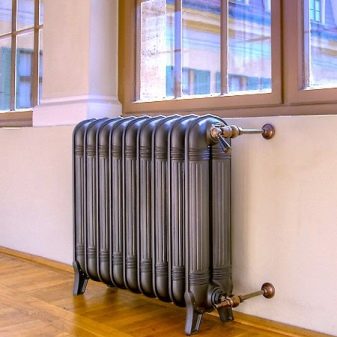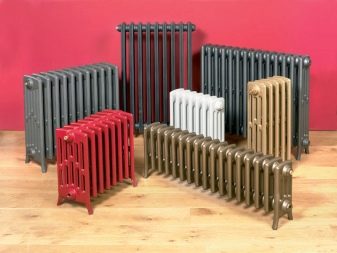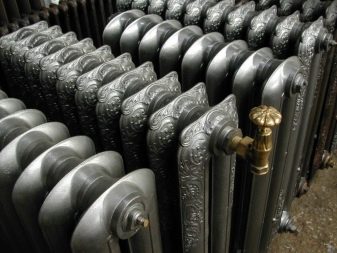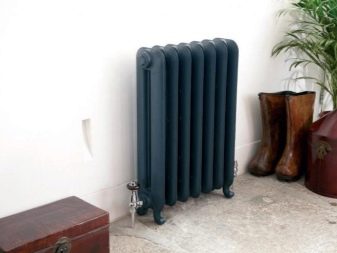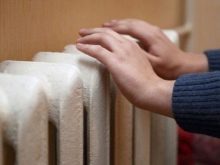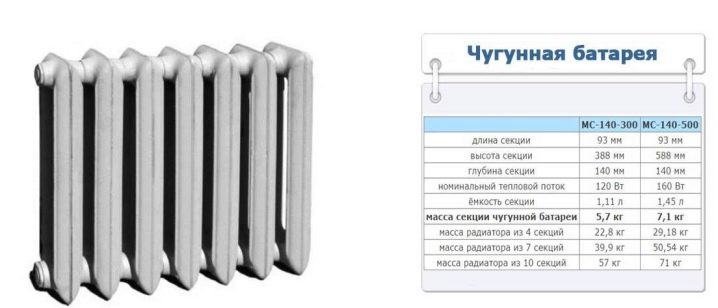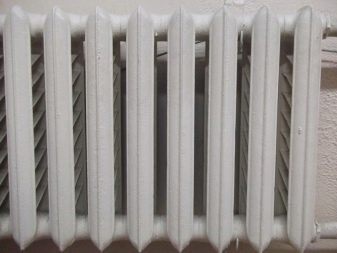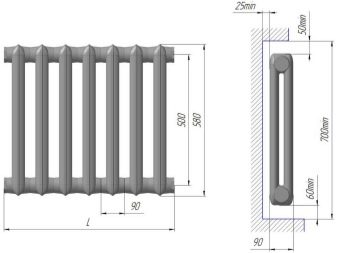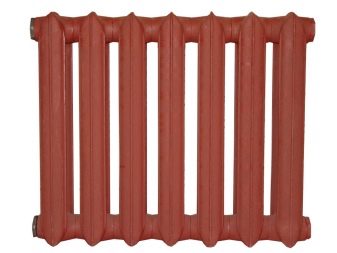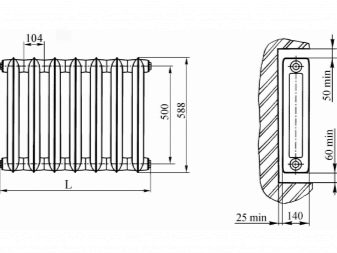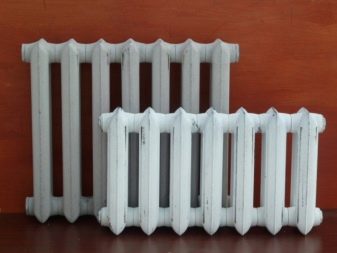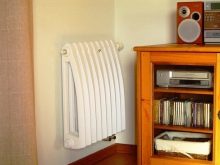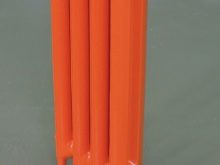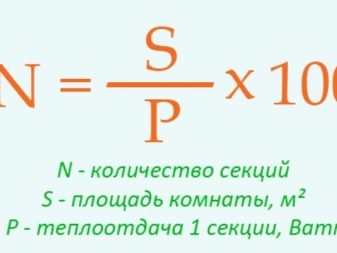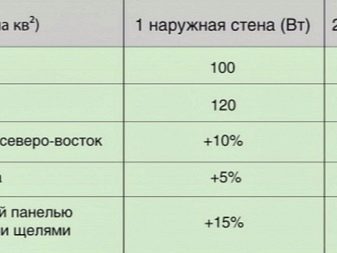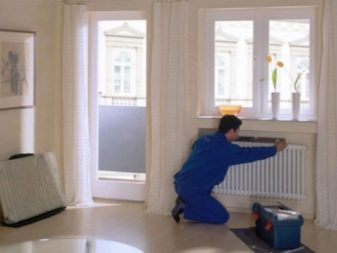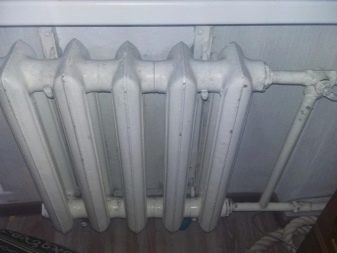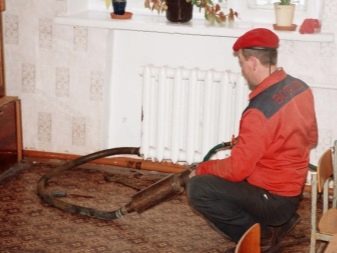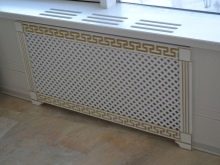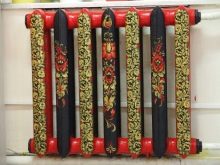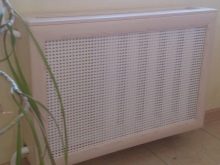How much does one section of a cast iron battery weigh?
Despite the continuous development of technologies in the field of heating systems, cast iron batteries are still a common heating device.
Cast iron radiators have a lot of advantages over more modern steel and aluminum competitors, and therefore remain popular for nearly two hundred years.
Special features
In the production section of the battery is made of cast iron and form one design using nipples. The joints are sealed with rubber or paronite gaskets. Channels filled with hot water can be round or elliptical.
Cast iron radiators can vary in width and height. The width depends on the number of sections, which, in turn, is determined by the area of the heated room.. Height usually ranges from 35 centimeters to one and a half meters. Batteries may vary in depth. Most often, this indicator has values from 50 to 140 centimeters and is selected depending on the interior design of the room.
Benefits
Among the advantages of cast iron batteries are the following:
- durability: the service life specified by the manufacturer is 50 years, but with proper care it can last much longer;
- resistance to pressure of 9–12 atmospheres, which provides protection against water hammer (therefore, cast iron radiators are commonly used in high-rise buildings with central heating);
- endurance temperature from 100 to 130 degrees;
- possibility of producing one section of power up to 160 kW;
- resistance to corrosive environments;
- no need for frequent cleaning;
- the ability to distribute heat to other objects due to infrared radiation;
- simple modification;
- the ability to install the battery required power;
- affordable cost.
disadvantages
In the use of cast iron radiators there are also disadvantages:
- large weight, which complicates transportation and installation;
- installation complexity requiring professional skills;
- long warm-up time due to the large volume of water;
- high load on the pump, which is forced to pump a significant amount of water in one warm-up cycle.
The disadvantages of cast iron radiators can also be attributed to designer uniformity, however, this indicator is currently progressing and developing.
Of course, an elegant design of cast iron does not make up, but now manufacturers produce batteries with a beautiful pattern on the surface. Such devices fit well into the interior, although they are much more expensive than simple equipment.
Weight
The question of how much one cast-iron section weighs is of interest to everyone who decided to purchase radiators. The average weight of a standard battery from 6 to 10 ribs is 50–58 kg. In a classic sectional battery, the weight of 1 cell is 7.5 kg.
A more specific indicator depends on the height, configuration and wall thickness.
Currently, manufacturers offer lightweight versions of gray cast iron batteries, but the old-style radiators are still in widespread use.
There are modern heavy installations, for example, especially popular now are vintage cast iron radiators.. The models are floor-standing devices made using art casting technology, the weight of one link can reach 12 kg.
Pig-iron batteries of the old sample are unpretentious in operation. They can be recognized by the name: the designation “MS” is an indispensable “satellite” of the names of old models, then numbers go through the dash, the first of which indicates the depth of the sections, and the second the distance between them.
Popular old style models
Ms 90
The MS-90 radiator can look like a four- or seven-section design. These batteries are ideally suited to Russian heating networks. Can be installed in industrial and residential premises.
Specifications:
- thermal power - from 130 W;
- width of one section - from 7.1 - 9 cm;
- height - from 58 to 58.1 cm;
- depth - from 9 cm;
- volume - from 1.15 - 1.45 l;
- weight of 1 section - from 5.48 - 6.5 kg;
- distance between axes - from 50 cm;
- temperature - up to 130 degrees;
- working pressure - 9 - 12 atm.
MS 140
Sectional radiators MS 140 is the only model that has “survived” to the present day since Soviet times. It is considered one of the most popular.It is used in rooms with low sill.
Specifications:
- thermal power - from 130 - 160 W;
- width of one section - from 9.3 - 6.65 cm;
- height - from 38.8 - 58 cm;
- depth - from 14 cm;
- volume - from 1.11 to 1.45 l;
- the weight of one section is from 5.4 to 6.65 kg;
- distance between the axes - from 30 - 50 cm;
- temperature - up to 130 ° C;
- working pressure - 9 - 12 atm.
Among the advantages of the old-style radiators are worth noting:
- practicality;
- high corrosion resistance;
- the possibility of using any coolant;
- high inertness.
The disadvantages are still heavy and unpresentable appearance.
Modern models
In Russia, the production of cast iron batteries began not so long ago, previously radiators were supplied from Europe and China. However, still imported constructions are considered to be of higher quality, however, and they are much more expensive.
The weight of sections of foreign batteries depends on the manufacturer. For example, the mass of the link of the popular Czech model Viadrus STYL 500 is 3.8 kg, and the weight of sections of Chinese models Konner company ranges from 3.5 to 4.75 kg (depending on individual heat transfer).
Famous Russian brand is the company EXEMET, which produces MODERN batteries, one “tooth” which weighs 3.3 kg.
Modern models look much more attractive: they can have a flat front panel and a flat surface. Some units are fully operational, while others require painting.
Tips
How to calculate power?
Before installing the radiators, it is necessary to calculate the required power in the desired room. Taking into account the fact that, in accordance with building codes, one square meter of space with standard ceilings of 2.7 meters sets 100 watts of thermal energy, we get the formula:
K = (S room x 100 W) / P, where K is the number of sections, S is the area of the room, P is the section power.
It should be remembered that in the corner room the number of sections should be increased by 25%, and in the presence of double-glazed windows, energy consumption is reduced by 10%.
Installation Tips
The most useful advice for installing cast iron batteries is to seek professional help. But if you are still confident in your abilities and intend to install the equipment yourself, then The following tips should be followed:
- determine the middle of the window opening, set aside the distances on both sides to the fasteners;
- place the radiator at a distance of 8-14 cm from the floor - this will facilitate the assembly process and will avoid the formation of cold zones;
- so that the convection is not disturbed and the heat output is not reduced, you should leave 10-12 cm between the sill and the battery;
- the clearance between the wall and the installation is 3-5 cm.
Stages of self-assembly:
- Screw the air vent into the adapter and place it on the upper manifold opposite the connection area of the supply pipe;
- install plugs on the collectors;
- mount shut-off and control valves;
- connect pipelines;
- when pressing open taps gradually.
Operation Tips
The service life of the heating system of cast iron is determined by several decades, but with proper operation of cast iron radiators, they may be enough for even more time.
For this you need:
- correctly and properly install the battery;
- wash radiators every season;
- maintain the purity of the elements;
- try not to knock on the batteries, not to touch them with heavy objects.
Do not forget also that the power can be increased and decreased by adding or removing additional sections.
How to hide?
Above more than once, a not too presentable type of cast iron radiators was noted. Therefore, many owners are concerned about how to harmoniously fit the battery in the interior of the house.
You can use these tips:
- installation of pipes in the walls of the room (it is possible to realize at the stages of construction or overhaul);
- purchase in advance of aesthetic modern equipment (today the range is diverse);
- painting in the right color, decoration;
- installation of rigid screens (they can be purchased at plumbing stores);
- the use of a special dense fabric that is attached with velcro to the wall or window sill;
- Batteries can be hidden by furniture (this method is suitable for the bathroom and toilet).
Conclusion
Thus, cast iron batteries - the most ponderous variant of the heating system, which creates difficulties during installation, but despite this, the radiators from cast iron are the best time-keeping devices for maintaining heat in the apartment. The equipment does not need special care, and the heavy weight and complexity of installation are compensated by a durable service and performance.
How to install a cast iron battery, see the following video.


